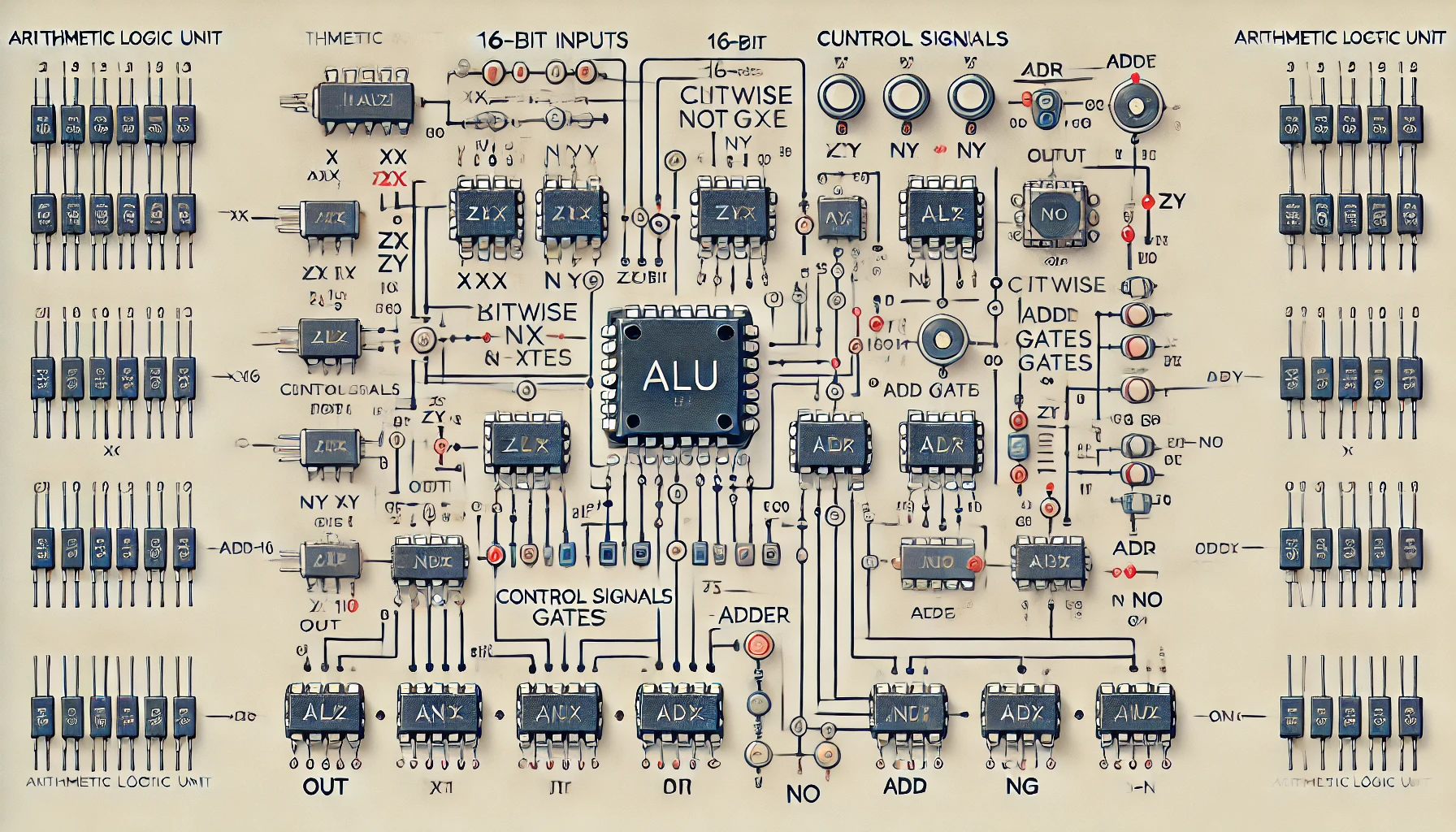Machineboy空
[From Nand to Tetris] Project 2 - HalfAdder, FullAdder, Add16, Inc16, ALU 본문
Computer/CS
[From Nand to Tetris] Project 2 - HalfAdder, FullAdder, Add16, Inc16, ALU
안녕도라 2025. 1. 23. 14:06만들 것
- HalfAdder
- FullAdder
- Add16
- Inc16
- ALU
기본 개념, 가산기(Adder)란?
컴퓨터의 기본 요소.
논리 대수에 따라서 동작하도록 반도체로 만든 논리 소자를 사용하여 구성한 회로.
입력값에 의해 불대수(boolean algebra)의 값이 출력되는 논리회로.
기억 능력은 가지지 않는다.
| 반가산기(Half Adder) | 전가산기(Full Adder) |
| 2진수로 나타낸 수들을 1비트씩 합하여 그 결과로 1비트의 합과 1비트의 자리올림(carry)을 발생하는 회로 | 자릿수가 많은 2진수의 덧셈에서 어떤 자리의 덧셈을 할 때, 낮은 자리로부터의 올림수를 고려한 2진 1자리의 가산기. |
| 일정한 수의 비트로 나타낸 수의 가산은 불가능 자리올림은 신호로 출력 |
이상은 지식백과 정의인데 무슨 말인지 잘 이해가 가지 않아서 강의를 찾아봤다
https://www.youtube.com/watch?v=F3vyljV4soo

완벽은 아니지만, Project 1때는 논리 연산도 제대로 이해하지 못하고 마구잡이로 했었구나 깨달았다.
HalfAdder

/**
* Computes the sum of two bits.
*/
CHIP HalfAdder {
IN a, b; // 1-bit inputs
OUT sum, // Right bit of a + b
carry; // Left bit of a + b
PARTS:
Xor(a = a, b = b, out = sum);
And(a= a, b= b, out= carry);
}FullAdder

/**
* Computes the sum of three bits.
*/
CHIP FullAdder {
IN a, b, c; // 1-bit inputs
OUT sum, // Right bit of a + b + c
carry; // Left bit of a + b + c
PARTS:
Xor(a = a, b = b, out = temp1);
And(a= a, b= b, out= temp2);
Xor(a = temp1, b = c, out = sum);
And(a= temp1, b= c, out= temp3);
Or(a= temp3, b= temp2, out= carry);
}Add16
/**
* 16-bit adder: Adds two 16-bit two's complement values.
* The most significant carry bit is ignored.
*/
CHIP Add16 {
IN a[16], b[16];
OUT out[16];
PARTS:
HalfAdder(a=a[0],b=b[0],sum=out[0],carry=c);
FullAdder(a=a[1],b=b[1],c=c,sum=out[1],carry=d);
FullAdder(a=a[2],b=b[2],c=d,sum=out[2],carry=e);
FullAdder(a=a[3],b=b[3],c=e,sum=out[3],carry=f);
FullAdder(a=a[4],b=b[4],c=f,sum=out[4],carry=g);
FullAdder(a=a[5],b=b[5],c=g,sum=out[5],carry=h);
FullAdder(a=a[6],b=b[6],c=h,sum=out[6],carry=i);
FullAdder(a=a[7],b=b[7],c=i,sum=out[7],carry=j);
FullAdder(a=a[8],b=b[8],c=j,sum=out[8],carry=k);
FullAdder(a=a[9],b=b[9],c=k,sum=out[9],carry=l);
FullAdder(a=a[10],b=b[10],c=l,sum=out[10],carry=m);
FullAdder(a=a[11],b=b[11],c=m,sum=out[11],carry=n);
FullAdder(a=a[12],b=b[12],c=n,sum=out[12],carry=o);
FullAdder(a=a[13],b=b[13],c=o,sum=out[13],carry=p);
FullAdder(a=a[14],b=b[14],c=p,sum=out[14],carry=q);
FullAdder(a=a[15],b=b[15],c=q,sum=out[15],carry=drop);
}
Inc16

/**
* 16-bit incrementer:
* out = in + 1
*/
CHIP Inc16 {
IN in[16];
OUT out[16];
PARTS:
HalfAdder(a=in[0],b= true,sum=out[0],carry=c);
HalfAdder(a=in[1],b= c,sum=out[1],carry=d);
HalfAdder(a=in[2],b= d,sum=out[2],carry=e);
HalfAdder(a=in[3],b= e,sum=out[3],carry=f);
HalfAdder(a=in[4],b= f,sum=out[4],carry=g);
HalfAdder(a=in[5],b= g,sum=out[5],carry=h);
HalfAdder(a=in[6],b= h,sum=out[6],carry=i);
HalfAdder(a=in[7],b= i,sum=out[7],carry=j);
HalfAdder(a=in[8],b= j,sum=out[8],carry=k);
HalfAdder(a=in[9],b= k,sum=out[9],carry=l);
HalfAdder(a=in[10],b= l,sum=out[10],carry=m);
HalfAdder(a=in[11],b= m,sum=out[11],carry=n);
HalfAdder(a=in[12],b= n,sum=out[12],carry=o);
HalfAdder(a=in[13],b= o,sum=out[13],carry=p);
HalfAdder(a=in[14],b= p,sum=out[14],carry=q);
HalfAdder(a=in[15],b= q,sum=out[15],carry=drop);
}ALU

/**
* ALU (Arithmetic Logic Unit):
* Computes out = one of the following functions:
* 0, 1, -1,
* x, y, !x, !y, -x, -y,
* x + 1, y + 1, x - 1, y - 1,
* x + y, x - y, y - x,
* x & y, x | y
* on the 16-bit inputs x, y,
* according to the input bits zx, nx, zy, ny, f, no.
* In addition, computes the two output bits:
* if (out == 0) zr = 1, else zr = 0
* if (out < 0) ng = 1, else ng = 0
*/
// Implementation: Manipulates the x and y inputs
// and operates on the resulting values, as follows:
// if (zx == 1) sets x = 0 // 16-bit constant
// if (nx == 1) sets x = !x // bitwise not
// if (zy == 1) sets y = 0 // 16-bit constant
// if (ny == 1) sets y = !y // bitwise not
// if (f == 1) sets out = x + y // integer 2's complement addition
// if (f == 0) sets out = x & y // bitwise and
// if (no == 1) sets out = !out // bitwise not
CHIP ALU {
IN
x[16], y[16], // 16-bit inputs
zx, // zero the x input?
nx, // negate the x input?
zy, // zero the y input?
ny, // negate the y input?
f, // compute (out = x + y) or (out = x & y)?
no; // negate the out output?
OUT
out[16], // 16-bit output
zr, // if (out == 0) equals 1, else 0
ng; // if (out < 0) equals 1, else 0
PARTS:
Mux16(a=x, b=false, sel=zx, out=l);
Not16(in=l, out=notl);
Mux16(a=l, b=notl, sel=nx, out=m);
Mux16(a=y, b=false, sel=zy, out=n);
Not16(in=n, out=notn);
Mux16(a=n, b=notn, sel=ny, out=o);
And16(a=m, b=o, out=p);
Add16(a=m, b=o, out=q);
Mux16(a=p, b=q, sel=f, out=r);
Not16(in=r, out=notr);
Mux16(a=r, b=notr, sel=no, out[15]=s, out[0..14]=t);
Mux16(a=r, b=notr, sel=no, out[0..7]=aa, out[8..15]=bb);
Or8Way(in=aa, out=xx);
Or8Way(in=bb, out=zz);
Or(a=xx, b=zz, out=yy);
Not(in=yy, out=zr);
Mux16(a=r, b=notr, sel=no, out=out);
Mux(a=false, b=true, sel=s, out=ng);
}


https://www.youtube.com/watch?v=Vtcm1oSSI0o





